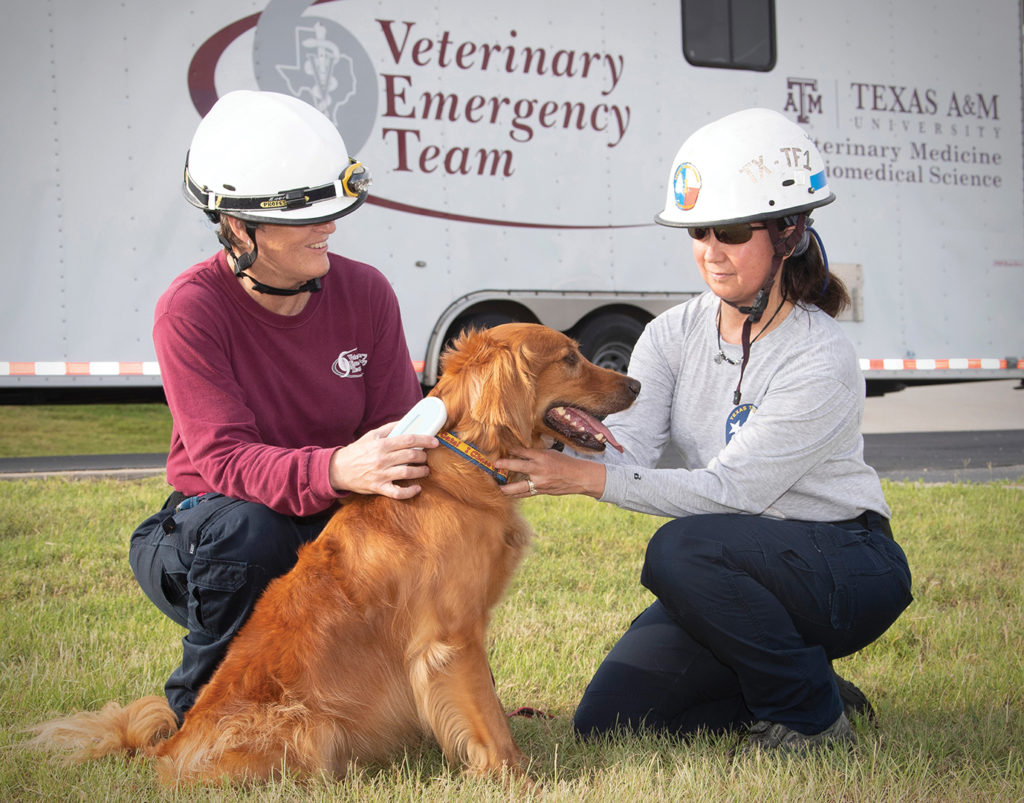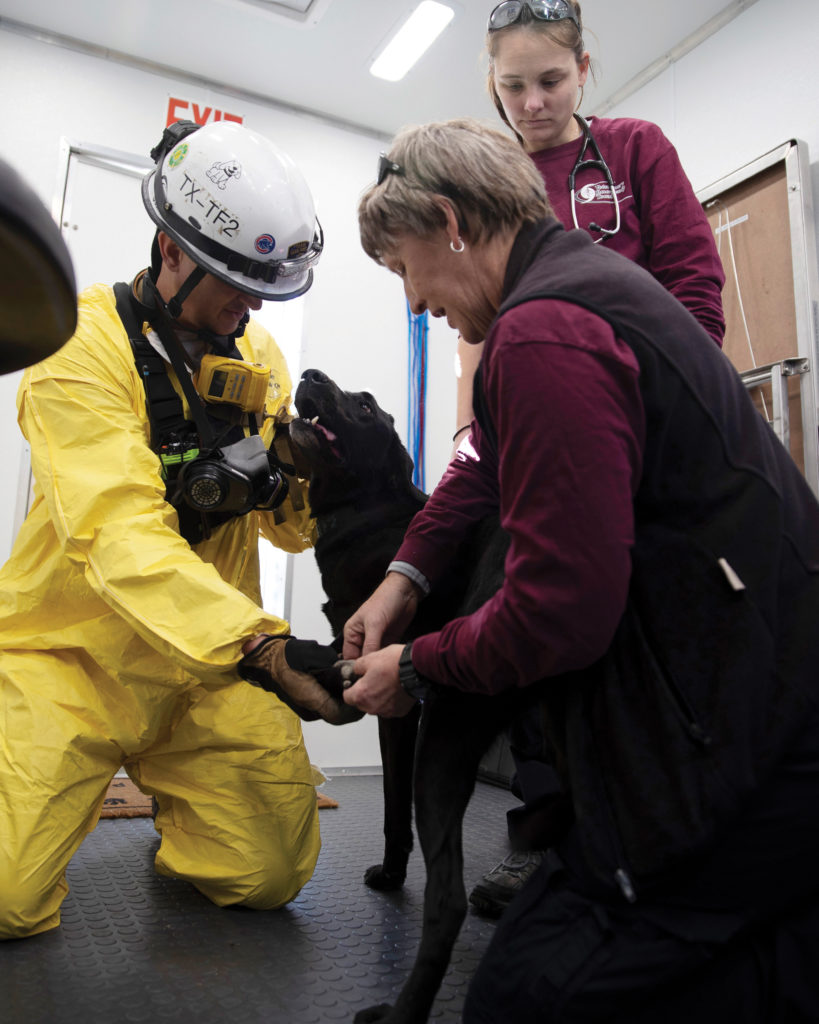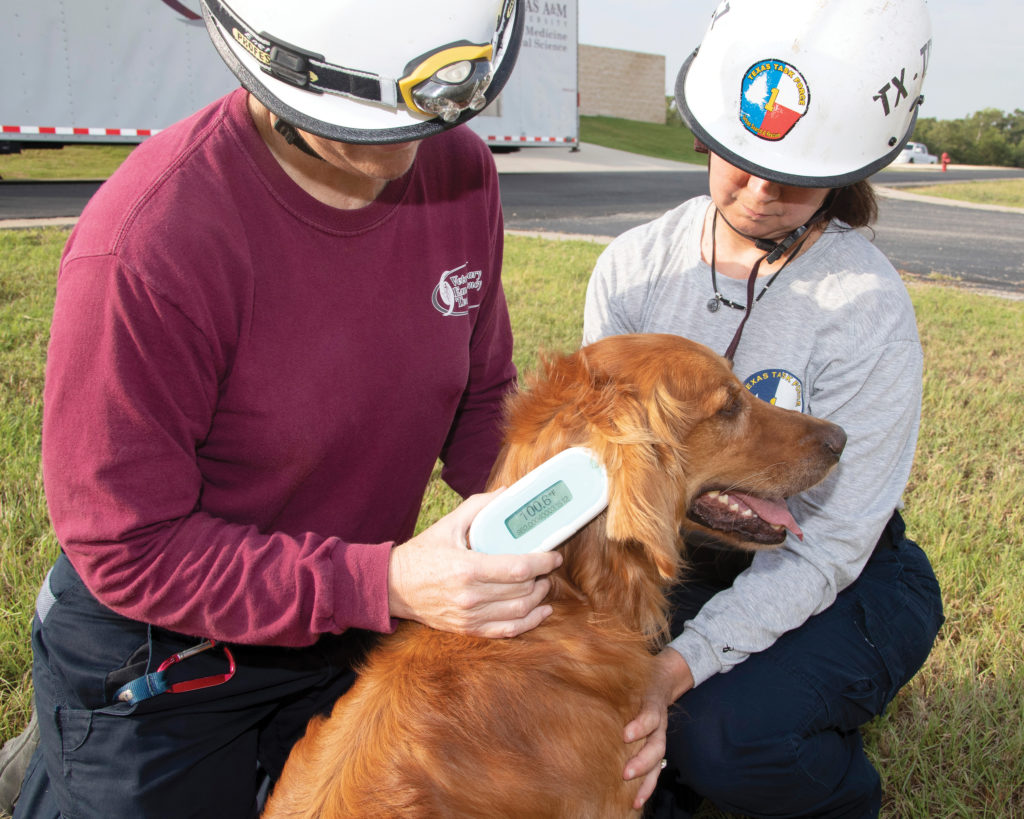Feeling the Heat
Story by Jennifer Gauntt, CVMBS Communications
Dr. Deb Zoran uses her work with Texas A&M Task Force urban search and rescue dogs to study how different breeds have unique temperature ranges and how that impacts their ability to save lives.

They are, perhaps, among the unsung heroes of the rescue world.
The canine members of the Texas A&M Task Force (TX-TF) urban search and rescue (SAR) teams can do many things their human counterparts can’t: their athletic frames and fearlessness allow them to squeeze into tight spaces, their agility allows them to maneuver unstable surfaces, and their exquisitely sensitive, trained noses allow them to sniff out the missing (through microscopic molecules in your breath!) to a precision unthinkable for humans.
The impact these dogs make cannot be denied. But the work is incredibly dangerous—the nature of the job requires them to work in all environments and around many hazards.
“The most successful SAR dogs are very highly driven; they do not make good pets. They are the most intense creatures in the dog world,” said Dr. Deb Zoran, a professor of small animal medicine in the Texas A&M College of Veterinary Medicine & Biomedical Sciences’ (CVM) Small Animal Clinical Sciences department (VSCS).
“When they and their handlers get deployed into a disaster, the mission is to find, save, or recover missing people, and they often have to go to work on a moment’s notice,” she said. “The first 48 to 72 hours are crucial in a disaster—that’s the critical timeframe you have to work in—and you don’t get to pick the circumstances.”
Zoran pulls double duty as a member of the Texas A&M Veterinary Emergency Team (VET) and the team veterinarian for TX-TF 1 & 2. For the past 10 years, her primary objective when training or deploying with either team is to keep these dogs healthy, at peak performance, and mission ready.
To her, the relationship between the SAR dogs, their handlers, and the veterinarian is of the utmost importance because while they’re working during a disaster—from wildfires to flooding responses and everything in between—SAR dogs depend on both their handler’s ability to recognize the tiniest differences in behavior or movement that may indicate injury and Zoran to support them before, during, and after a mission.
“When they are deployed in our Texas climate, they are at particular risk of hyperthermia, dehydration, and many injuries—muscle strains or trauma to their legs or foot pads—as well as for interactions with snakes/scorpions, fire ants, and other hazards that can happen in the process,” Zoran said.
“Despite these hazards, there are two recurring risks for the dogs as they work more or less year-round in the southern U.S., and those are overheating and dehydration,” Zoran said. “Both impact the dogs’ ability to complete the search, which then affects the team’s ability to find that missing human; both also have a profound impact on the canine nose’s scenting function, because dehydration, in particular, reduces the ability for noses to uptake odor, while overheating makes the nose’s internal membranes dry out, also reducing the ability to detect odor.”

A challenge each handler must face in the field is knowing how to spot when their dog may be getting too dehydrated or overheated, as SAR dogs work at an intensity that can be detrimental. Most handlers are not trained in animal care, and it is not possible for Zoran, or the VET, to be with each dog as it works in the field.
So when Zoran met Dr. Marta LaColla, the veterinary business manager of Allflex USA, and learned about their product SureSense, a microchip that had primarily been used for monitoring dairy cattle and cattle in feedlots, Zoran wondered if the product might be useful for SAR teams.
“When Marta approached me and said, ‘We have developed a temperature-sensing microchip; we’ve been looking at it in shelter animals for the past year and we’re ready now to put it out in the field,’ my answer was, ‘Absolutely,’” Zoran said. “They had not yet used the temperature microchip in many dogs, but the concept was immediately interesting.”
As Zoran saw it, a temperature-sensing microchip would solve a lot of problems. While she has taught handlers how to perform basic health checks on their dogs, taking a rectal temperature—the most common and accurate method to check temperature—in a working dog can be extremely challenging, if not impossible, in the field.
Finding new ways for handlers to monitor their SAR dogs’ body temperatures has been one of Zoran’s research interests over the past four years; she previously tried a thermistor capsule the dogs could swallow to measure temperature while they worked.
Allflex and Zoran worked out an arrangement to provide free microchips and specially designed microchip readers to the SAR teams, and, in return, Zoran developed a clinical trial protocol to collect temperature data, compare that data between different chip methods, and, over time, compare differences between work/rest cycles in training and deployments, as well as different environmental conditions.
It was a win-win situation for everyone involved.
“The whole idea behind the temp-sensing microchip and why it was powerful and valuable was because temperature monitoring by handlers essentially did not happen in the field; it was too hard to do,” she said. “With a SureSense reader in their pocket, the handlers can easily scan the area where the microchip was inserted and keep track of their dog’s temperature in real time.”
For research purposes, the captured data can be viewed through an app, downloaded by the handler, or directly uploaded to the cloud, where it is sent to Zoran and the Allflex team. By tracking temperatures in everything the dogs do, Zoran and Allflex were able to start establishing baseline and working temperatures by breed, sex, coat type, and other key variables.
Over time and with experience, Zoran has learned that each dog’s temperature ranges are unique.

“Some of these dogs have relatively narrow ranges of temperature excursion; others, like many of our Labradors, really have wide ranges of temperature excursion,” she said. “For example, at rest, some of the Labs will have a resting temperature of 100 degrees, but as soon as they start work, it will jump to 103 degrees, and on hot days, with as little as 20 or 25 minutes of intense search work, they will have a temperature approaching 106 degrees.
“Other dogs on the team, with similar fitness levels and body conditions, will top out at 104-105 degrees after that same amount of work and need to rest,” Zoran said. “What does that mean? Are there wide temperature excursions in Labradors because of genetics? Muscle mass? Diet?”
Understanding the breed differences in working dogs is, ultimately, both a safety issue and a mission-success issue and allows Zoran to give each SAR dog more individualized care to better fit their capabilities.
“These readers have become exceedingly valuable,” Zoran said. “The handlers and dogs can be out working during a deployment, but we are still in contact by radio, so they can tell me what’s going on with their dogs, and then we can adjust their work cycle based on this information.”
So far, data have been collected from more than 40 dogs through three summer seasons, and Zoran will be working to publish a paper on the project soon.
“There are things that we don’t understand about heat impacts on working dogs and this information could lead to the next generation of studies,” she said. “I see a lot of different opportunities to learn about these fascinating athletes in the future.
“The original goal of this project was to prove that the SureSense microchip enhances our ability to monitor these dogs closely and have a better work plan that still keeps them in the field, but allows us to intervene when we need to,” Zoran said. “That comes from just getting a lot of data from many different dogs in different working conditions.”
To advance that idea, the project is ongoing, and in addition to the TX-TF canines, Zoran has recruited SAR dogs from Texas Parks and Wildlife and the local Search Dog Network to be included in the project.
“A certified SAR dog is one of the most valuable members on a search and rescue team for finding a missing person,” Zoran said, adding that whether they are searching to find a living person or working to give a family closure by finding a deceased person, their value cannot be underestimated. “These dogs are pretty amazing animals, and it is a true joy for me to work with both the handlers and dogs and to be a part of keeping these incredible teams on mission.”
###
This story originally appeared in the Fall 2019 edition of CVM Today.
For more information about the Texas A&M College of Veterinary Medicine & Biomedical Sciences, please visit our website at vetmed.tamu.edu or join us on Facebook, Instagram, and Twitter.
Contact Information: Jennifer Gauntt, Director of CVMBS Communications, Texas A&M College of Veterinary Medicine & Biomedical Sciences; jgauntt@cvm.tamu.edu; 979-862-4216



